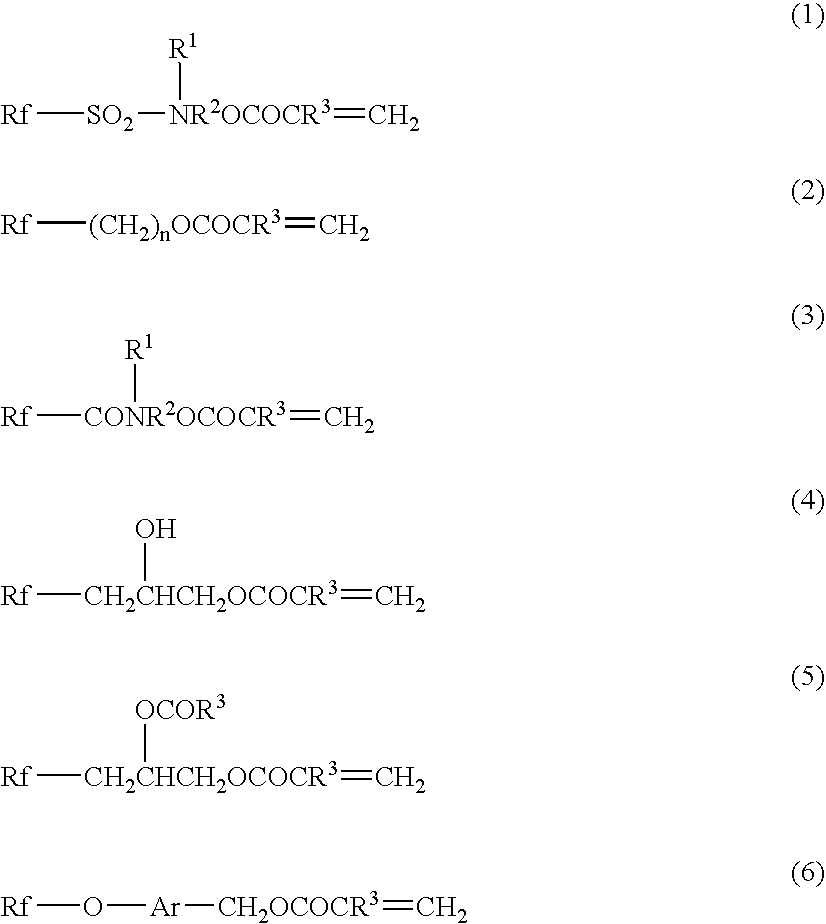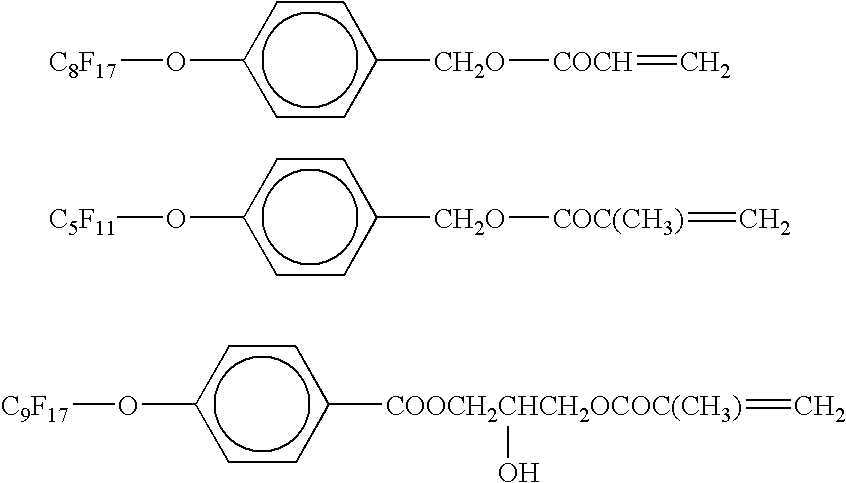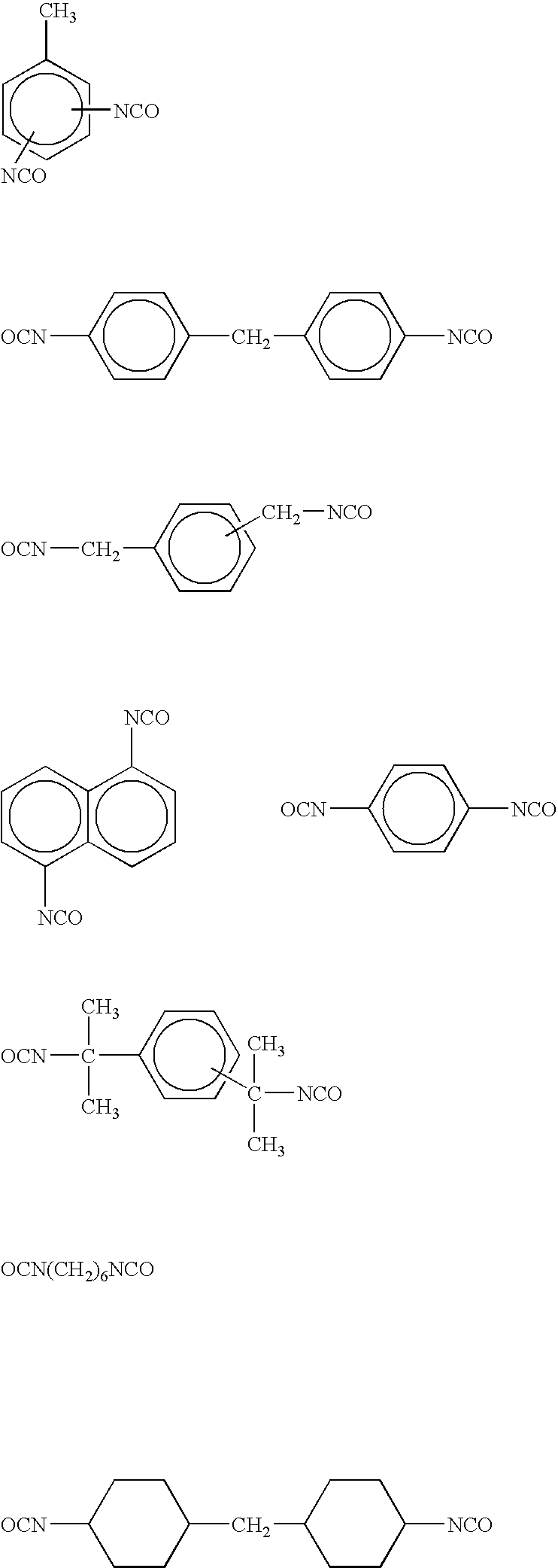Water- and oil-repellent treatment of textile
a technology of textiles and oil repellents, applied in the direction of liquid repellent fibres, other chemical processes, coatings, etc., can solve the problems of insufficient water repellency, oil repellency and soil releasability, and achieve excellent water repellency, oil repellency and soil releasability, and the effect of durable
- Summary
- Abstract
- Description
- Claims
- Application Information
AI Technical Summary
Benefits of technology
Problems solved by technology
Method used
Image
Examples
example 3
PREPARATIVE EXAMPLE 3
[0117]50 g of perfluoroalkyl acrylate: CH2═CH—COOCH2CH2—Rf (a mixture wherein a molar ratio of Rf═C6F13, C8F17, C10F21, C12F25 and C14F29 was 2:40:30:15:3, an average molecular weight of 528), 15 g of stearyl acrylate and 15 g of 2-ethyihexyl methacrylate were sufficiently mixed and dissolved. 3 g of sorbitan mono-oleate (a nonionic emulsifier), 3 g of polyoxyethylene(n=20)lauryl ether (a nonionic emulsifier), 12 g of sodium lauryl sulfate (an anionic emulsifier, pKa=2), 0.15 g of lauryl mercaptan, 25 g of tripropylene glycol and 160 g of deionized water were added and the mixture was emulsified by a high pressure homogenizer. The resultant emulsion was charged into a 500 mL four-necked flask equipped with a reflux condenser, a nitrogen introducing tube, a thermometer and a stirrer, and the emulsion was maintained under a nitrogen flow at 60° C. for about 1 hour. A solution of an initiator, ammonium persulfate (0.5 g) in water (5 g) was added to initiate the pol...
example 4
PREPARATIVE EXAMPLE 4
[0118]200 g of perfluoroalkyl acrylate: CH2═CH—COOCH2CH2—Rf (a mixture wherein a molar ratio of Rf═C6F13, C8F17, C10F21, C12F25 and C14F29 was 2:40:30:15:3, an average molecular weight of 528) and 15 g of stearyl acrylate were sufficiently mixed and dissolved. 20 g of polyoxyethylene(n=15)octyl phenyl ether (a nonionic emulsifier), 10 g of sodium lauryl sulfate (an anionic emulsifier, pKa=2), 0.15 g of lauryl mercaptan, 70 g of tripropylene glycol and 450 g of deionized water were added and the mixture was emulsified by a high pressure homogenizer. The resultant emulsion was charged into a 1 L autoclave, and the atmosphere was replaced with nitrogen. 70 g of vinyl chloride was pressed into the autoclave. A solution of an initiator, ammonium persulfate (1.5 g) in water (10 g) was added and the temperature of the mixture was increased to 60° C. to initiate the polymerization. The mixture was stirred at 60° C. for 6 hours to give an aqueous emulsion of a copolymer....
example 1
[0119]0.9 g of the emulsion prepared in Preparative Example 1 and 5 g of a stain blocking agent (FX-657, manufactured by 3M) were diluted with water to the amount of 1,000 g. A 10% aqueous sulfamic acid solution was added to the emulsion so that pH of the emulsion was 1.5, to give a treatment liquid.
[0120]A carpet (8.9 cm×18.2 cm, nylon-6,6, cut pile, density: 36 oz / yd2) was immersed in this treatment liquid for 30 seconds and squeezed to have a WPU (wet pick up) amount of 300%. Then, a normal-pressure steamer treatment (temperature: 100° C. to 107° C.) was conducted for 90 seconds under the state that a pile surface was upside. The carpet was lightly rinsed with 2 L of water and then centrifugal dehydration was conducted to give a WPU amount of 25%. Finally, the carpet was thermally cured at 110° C. for 10 minutes. Then, the evaluation of water repellency and adhesion rate was conducted. The results are shown in Table A.
PUM
| Property | Measurement | Unit |
|---|---|---|
| Percent by volume | aaaaa | aaaaa |
| Percent by volume | aaaaa | aaaaa |
| Percent by volume | aaaaa | aaaaa |
Abstract
Description
Claims
Application Information
 Login to View More
Login to View More - Generate Ideas
- Intellectual Property
- Life Sciences
- Materials
- Tech Scout
- Unparalleled Data Quality
- Higher Quality Content
- 60% Fewer Hallucinations
Browse by: Latest US Patents, China's latest patents, Technical Efficacy Thesaurus, Application Domain, Technology Topic, Popular Technical Reports.
© 2025 PatSnap. All rights reserved.Legal|Privacy policy|Modern Slavery Act Transparency Statement|Sitemap|About US| Contact US: help@patsnap.com



